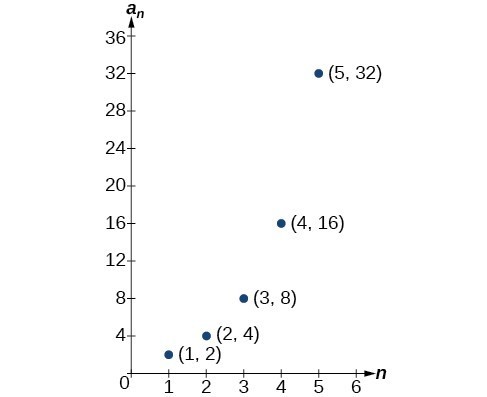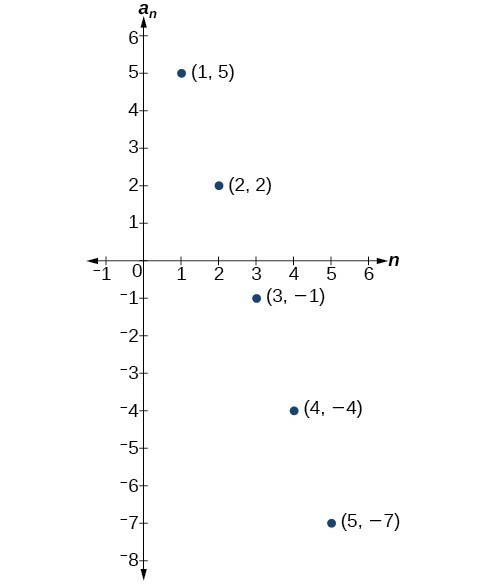Sequences Defined by an Explicit Formula
Learning Objectives
- Write the terms of a sequence defined by an explicit formula
- Write the formula for the nth term of a sequence
- Find the terms of an alternating sequence
[latex]\left\{2,4,8,16,32,\dots \right\}[/latex].
The ellipsis (…) indicates that the sequence continues indefinitely. Each number in the sequence is called a term. The first five terms of this sequence are 2, 4, 8, 16, and 32. Listing all of the terms for a sequence can be cumbersome. For example, finding the number of hits on the website at the end of the month would require listing out as many as 31 terms. A more efficient way to determine a specific term is by writing a formula to define the sequence. One type of formula is an explicit formula, which defines the terms of a sequence using their position in the sequence. Explicit formulas are helpful if we want to find a specific term of a sequence without finding all of the previous terms. We can use the formula to find the [latex]n\text{th}[/latex] term of the sequence, where [latex]n[/latex] is any positive number. In our example, each number in the sequence is double the previous number, so we can use powers of 2 to write a formula for the [latex]n\text{th}[/latex] term. The first term of the sequence is [latex]{2}^{1}=2[/latex], the second term is [latex]{2}^{2}=4[/latex], the third term is [latex]{2}^{3}=8[/latex], and so on. The [latex]n\text{th}[/latex] term of the sequence can be found by raising 2 to the [latex]n\text{th}[/latex] power. An explicit formula for a sequence is named by a lower case letter [latex]a,b,c..[/latex]. with the subscript [latex]n[/latex]. The explicit formula for this sequence is
[latex]{a}_{n}={2}^{n}[/latex].
Now that we have a formula for the [latex]n\text{th}[/latex] term of the sequence, we can answer the question posed at the beginning of this section. We were asked to find the number of hits at the end of the month, which we will take to be 31 days. To find the number of hits on the last day of the month, we need to find the 31st term of the sequence. We will substitute 31 for [latex]n[/latex] in the formula.
The first term of the sequence is [latex]{2}^{1}=2[/latex], the second term is [latex]{2}^{2}=4[/latex], the third term is [latex]{2}^{3}=8[/latex], and so on. The [latex]n\text{th}[/latex] term of the sequence can be found by raising 2 to the [latex]n\text{th}[/latex] power. An explicit formula for a sequence is named by a lower case letter [latex]a,b,c..[/latex]. with the subscript [latex]n[/latex]. The explicit formula for this sequence is
[latex]{a}_{n}={2}^{n}[/latex].
Now that we have a formula for the [latex]n\text{th}[/latex] term of the sequence, we can answer the question posed at the beginning of this section. We were asked to find the number of hits at the end of the month, which we will take to be 31 days. To find the number of hits on the last day of the month, we need to find the 31st term of the sequence. We will substitute 31 for [latex]n[/latex] in the formula.
[latex]\begin{array}{l}{a}_{31}={2}^{31}\hfill \\ \text{ }=\text{2,147,483,648}\hfill \end{array}[/latex]
If the doubling trend continues, the company will get [latex]\text{2,147,483,648}[/latex] hits on the last day of the month. That is over 2.1 billion hits! The huge number is probably a little unrealistic because it does not take consumer interest and competition into account. It does, however, give the company a starting point from which to consider business decisions. Another way to represent the sequence is by using a table. The first five terms of the sequence and the [latex]n\text{th}[/latex] term of the sequence are shown in the table.| [latex]n[/latex] | 1 | 2 | 3 | 4 | 5 | [latex]n[/latex] |
| [latex]n\text{th}[/latex] term of the sequence, [latex]{a}_{n}[/latex] | 2 | 4 | 8 | 16 | 32 | [latex]{2}^{n}[/latex] |
 Lastly, we can write this particular sequence as
Lastly, we can write this particular sequence as
[latex]\left\{2,4,8,16,32,\dots ,{2}^{n},\dots \right\}[/latex].
A sequence that continues indefinitely is called an infinite sequence. The domain of an infinite sequence is the set of counting numbers. If we consider only the first 10 terms of the sequence, we could write[latex]\left\{2,4,8,16,32,\dots ,{2}^{n},\dots ,1024\right\}[/latex].
This sequence is called a finite sequence because it does not continue indefinitely.A General Note: Sequence
A sequence is a function whose domain is the set of positive integers. A finite sequence is a sequence whose domain consists of only the first [latex]n[/latex] positive integers. The numbers in a sequence are called terms. The variable [latex]a[/latex] with a number subscript is used to represent the terms in a sequence and to indicate the position of the term in the sequence.[latex]{a}_{1},{a}_{2},{a}_{3},\dots ,{a}_{n},\dots [/latex]
We call [latex]{a}_{1}[/latex] the first term of the sequence, [latex]{a}_{2}[/latex] the second term of the sequence, [latex]{a}_{3}[/latex] the third term of the sequence, and so on. The term [latex]{a}_{n}[/latex] is called the [latex]n\text{th}[/latex] term of the sequence, or the general term of the sequence. An explicit formula defines the [latex]n\text{th}[/latex] term of a sequence using the position of the term. A sequence that continues indefinitely is an infinite sequence.Q & A
Does a sequence always have to begin with [latex]{a}_{1}?[/latex]
No. In certain problems, it may be useful to define the initial term as [latex]{a}_{0}[/latex] instead of [latex]{a}_{1}[/latex]. In these problems, the domain of the function includes 0.How To: Given an explicit formula, write the first [latex]n[/latex] terms of a sequence.
- Substitute each value of [latex]n[/latex] into the formula. Begin with [latex]n=1[/latex] to find the first term, [latex]{a}_{1}[/latex].
- To find the second term, [latex]{a}_{2}[/latex], use [latex]n=2[/latex].
- Continue in the same manner until you have identified all [latex]n[/latex] terms.
Example: Writing the Terms of a Sequence Defined by an Explicit Formula
Write the first five terms of the sequence defined by the explicit formula [latex]{a}_{n}=-3n+8[/latex].Answer: Substitute [latex]n=1[/latex] into the formula. Repeat with values 2 through 5 for [latex]n[/latex].
[latex]\begin{array}{llllll}n=1\hfill & \hfill & \hfill & \hfill & \hfill & {a}_{1}=-3\left(1\right)+8=5\hfill \\ n=2\hfill & \hfill & \hfill & \hfill & \hfill & {a}_{2}=-3\left(2\right)+8=2\hfill \\ n=3\hfill & \hfill & \hfill & \hfill & \hfill & {a}_{3}=-3\left(3\right)+8=-1\hfill \\ n=4\hfill & \hfill & \hfill & \hfill & \hfill & {a}_{4}=-3\left(4\right)+8=-4\hfill \\ n=5\hfill & \hfill & \hfill & \hfill & \hfill & {a}_{5}=-3\left(5\right)+8=-7\hfill \end{array}[/latex] The first five terms are [latex]\left\{5,2,-1,-4,-7\right\}[/latex].
Analysis of the Solution
The sequence values can be listed in a table. A table is a convenient way to input the function into a graphing utility.| [latex]n[/latex] | 1 | 2 | 3 | 4 | 5 |
| [latex]{a}_{n}[/latex] | 5 | 2 | –1 | –4 | –7 |

Try It
Write the first five terms of the sequence defined by the explicit formula [latex]{t}_{n}=5n - 4[/latex].Answer: The first five terms are [latex]\left\{1,6, 11, 16, 21\right\}[/latex]
Try It
Write an explicit formula for the [latex]n\text{th}[/latex] term of the sequence.Answer: [latex]{a}_{n}=-\frac{{3}^{n}}{4n}[/latex]
Licenses & Attributions
CC licensed content, Original
- Revision and Adaptation. Provided by: Lumen Learning License: CC BY: Attribution.
CC licensed content, Shared previously
- College Algebra. Provided by: OpenStax Authored by: Abramson, Jay et al.. License: CC BY: Attribution. License terms: Download for free at http://cnx.org/contents/[email protected].
- Question ID 5846, 5823. Authored by: Webwork-Rochester. License: CC BY: Attribution. License terms: IMathAS Community License CC-BY + GPL.
- Question ID 5805, 5806. Authored by: David Lippman. License: CC BY: Attribution. License terms: IMathAS Community License CC-BY + GPL.
CC licensed content, Specific attribution
- Precalculus. Provided by: OpenStax Authored by: OpenStax College. Located at: https://cnx.org/contents/[email protected]:1/Preface. License: CC BY: Attribution.
